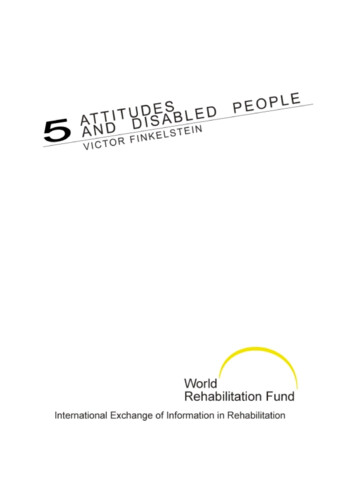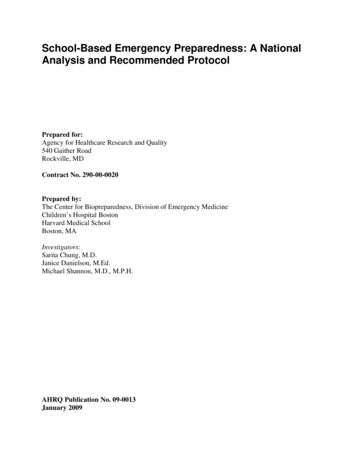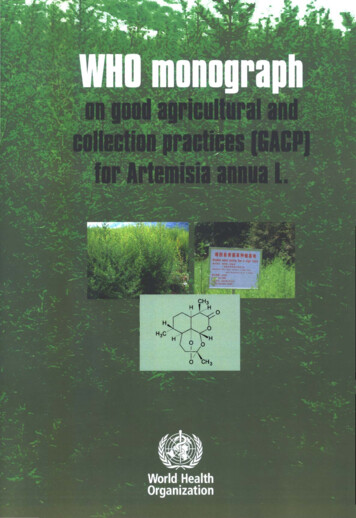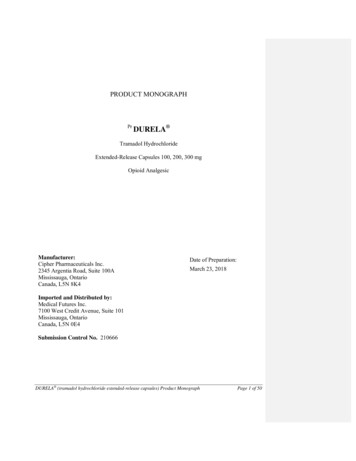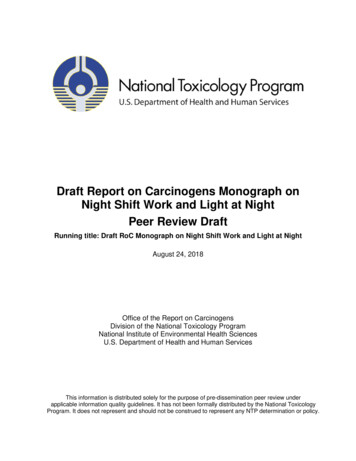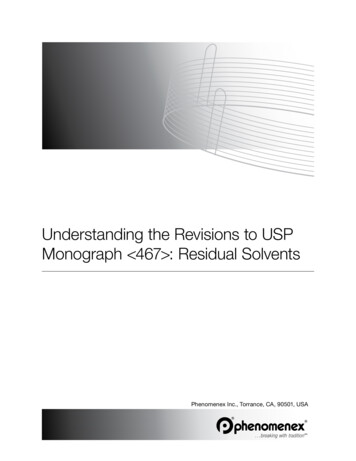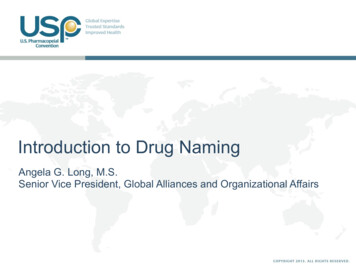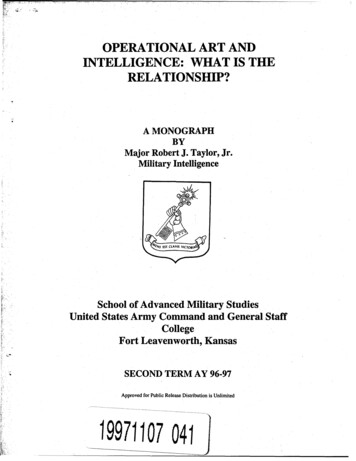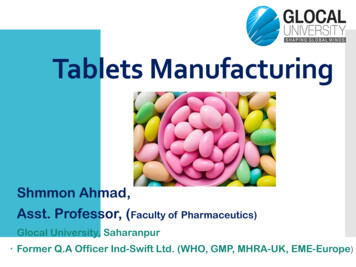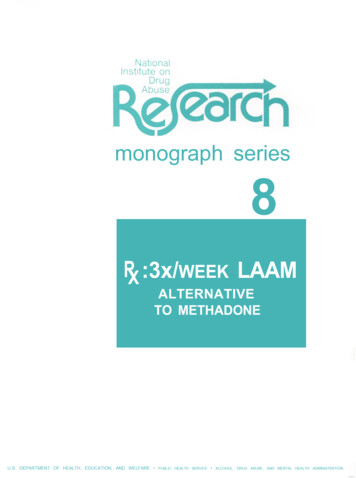
Transcription
monograph series8RX :3x/WEEK LAAMALTERNATIVETO METHADONEU.S. DEPARTMENT OF HEALTH, EDUCATION, AND WELFARE PUBLIC HEALTH SERVlCE ALCOHOL, DRUG ABUSE, AND MENTAL HEALTH ADMINISTRATION
PX : 3 X /WEEK LAAMALTERNATIVE TO METHADONEEDITORSJACK D. BLAINE, M.D.PIERRE F. RENAULT, M.D.NIDA Research Monograph 8
The NIDA Research Monograph series is prepared by theDivision of Research of the National Institute on Drug Abuse. Itsprimary objective is to provide critical reviews of research problemareas and techniques, the content of state-of-the-art conferences,integrative research reviews and significant original research. Itsdual publication emphasis is rapid and targeted dissemination to thescientific and professional community.EDITORIAL ADVISORY BOARDAvram Goldstein, M.D.Jerome Jaffe, M.D.Reese T. Jones, M.D.William McGlothlin, Ph.D.Jack Mendelson, M.D.Helen Nowlis, Ph.D.Lee Robins, Ph.D.Addiction Research FoundationPalo Alto, CaliforniaCollege of Physicians and SurgeonsColumbia University. New YorkLangly Porter Neuropsychiatric InstituteUnversity of CaliforniaSan Francisco, CaliforniaDepartment of Psychology, UCLALos Angeles, CaliforniaAlchohol and Drug abuse Research CenterHavard Medical SchoolMcLean HospitalBelmont, MassachusetttsOffice of Drug Education, DHEWWashington, D.C.Walhington University School, of MedicineSt. Louis, MissouriNIDA RESEARCH MONOGRAPH seriesRobert DuPont, M.D. DIRECTOR, NIDAWilliam Pollin, M.D. DIRECTOR, DIVISION OF RESEARCH, NIDARobert C. Petersen, Ph.D. EDITOR-IN-CHIEFEunice L. Corfman, M.A. EDITOR
Rx :3 x /WEEK LAAMALTERNATIVE TO METHADONEEDITORSJACK D. BLAINE, M.D.PIERRE F. RENAULT, M.D.Division of ResearchNational Institute on Drug AbuseJuly 1976NIDA Reseach Monograph 8THE NATlONAL INSTlTUTE ON DRUG ABUSE5600 Fishers LaneRockville. Maryland 20857U.S. DEPARTMENT OF HEALTH, EDUCATION, AND WELFAREPublic Health Service
DHEW Publication No. (ADM)78-347Formerly DHEW Publication No. (ADM)76-347Printed 1976Reprinted 1977Library of Congress catalog number 76-20257For sale by the National Technical Information ServiceSpringfield, Va. 22161Stock order #PB 253 763; Papercopy: 7.25; Microfiche: 3.00iv
FOREWORDThis monograph is a biomedical review and assessmentof LAAM (Levo-alpha acetylmethadol), a new treatmentdrug for heroin addiction now undergoing large scaleclinical trials, following several years' intensiveresearch and development under the auspices of theNational Institute on Drug Abuse (NIDA) and its predecessor, the Special Action Office for Drug AbusePrevention (SAODAP).LAAM was developed as an alternative to methadone.Over 800 methadone-related deaths per year are beingreported by the Drug Abuse Warning Network (DAWN)from 24 major cities across the country. Moreover,heroin use has been increasing nationally since mid1973 and 15 percent of heroin-related deaths (from1,440 in 1973 to over 2,000 in 1975) reported byDAWN also involve methadone.Many of these deaths are directly attributable toillicit methadone diversion from drug treatment programs to street sale. Because methadone patientsmust take their dose daily while simultaneously trying to stabilize their work, school, training, familyand personal lives, they have been allowed take-homedoses to reduce the number of clinic visits they mustmake. But this practice has made methadone widelyavailable, accounting for much illicit diversion andsubsequent painful record of methadone overdose deaths.In contrast, LAAM dosage is three times a week, itdoes not yield a quick high and appears to provide alevel, sustained effect. Animal toxicity studiesand clinical research experience indicate that LAAMis a safe and effective opiate maintenance drug,under appropriate medical supervision.A wide spectrum of treatments is needed for variousdegrees of addiction and kinds of dependent persons.But LAAM seems promising for patients who may needopiate stabilization to ease the difficult switchfrom a drug-hustling street life to a less selfdestructive one. LAAM provides one more choice intailoring treatment to each individual's needs.Robert L. DuPont, M.D.DirectorNational Institute on Drug Abusev
CONTENTSForewordRobert L. DuPont, M.D.vIntroductionJack Blaine, M.D. and Pierre Renault, M.D.1The Chemistry of LAAMSydney Archer, Ph.D.10PRECLINICAL STUDIESPharmacology of LAAMSydney Archer, Ph.D.15Toxicology of LAAMMs. Ann Wolven and Sydney Archer, Ph.D.29CLINICAL STUDIESPhase IRalph M. Sollod, M.S., and Marcia G. Goldstein, M.A.39Selected Clinical Studies Synopses52Sumnary of Veterans Administration Phase II Cooperative Study for LAAM and MethadoneWalter Ling, M.D.V. Charles Chamvastra, M.D.Samuel C. Kaim, M.D.C. James Klett, Ph.D.94Summary of SAODAP Phase II Cooperative Study of LAAM vs. MethadoneWalter Ling, M.D.C. James Klett, Ph.D.Roderic D. Gillis103Phase III Clinical Study of Levo-Alpha-AcetylmethadolJohn A. Whysener, M.D., Ph.D.109The Use of LAAM in TreatmentJames Cooper, M.D.112A Clinical Experience with LAAMAvram Goldstein, M.D.115A LAAM BibliographyPreclinicalClinical118123vii
INTRODUCTIONJack Blaine, M.D. and Pierre Renault, MD.MEDICAL DETOXIFICATIONproblems arising from the need to administerthe drug intravenously several times daily.For many years heroin addicted individualswere "treated" by abrupt or gradual discontinuation of heroin, leading to abstinence.Resulting withdrawal symptoms were eitheruntreated or treated palliatively with nonopiate medications including sleeping pills,tranquilizers, analgesics, antidiarrheals,and/or antispasmodics. The failure of heroinwithdrawal alone as a treatment with the goalof long-term continued abstinence has beenvoluminously documented.METHADONE DETOXIFICATIONDuring World War II, German chemists at theI.G. Farbenindustrie developed a syntheticnarcotic analgesic, 6-dimethylamino-4-4-dipheny1-3-heptanone (methadone, dolorphine) as a substitute for morphine. After the war, Americaninvestigators (Isbell et al. 1948) found thatmethadone’s pharmacological pmfile wassimilar to that of morphine and demonstratedthat methadone could substitute for morphinein morphine-dependent subjects to relieve theabstinence symptoms after discontinuation ofmorphine. Furthermore, methadone could prevent the appearance of withdrawal signs andsymptoms when substituted for morphine inequipotent doses. So methadone seemed alikely candidate to substitute for heroin whendetoxifying heroin addicts.At best, medically controlled detoxificationhas only inmediate and temporary value as afirst step in a comprehensive rehabilitationprogram. Thus, regulated detoxificationreduces human suffering and frees the individual from his compulsive search for and useof the drug, permitting a shift in attentionto other more constructive pursuits. Longperiods of confinement in a hospital, therapeutic commmity, or prison, even with traditional psychotherapeutic intervention have notsignificantly altered subsequent relapse toheroin abuse for the vast majority of addicts.Methadone has several advantages over morphinefor detoxification of heroin dependent persons.Methadone is almost as effective orally asparenterally, thus avoiding problems of intravenous dosage. Also, methadone is metabolizedto inactive substances more slowly thanmorphine. These two factors extend the duration of action of methadone to 24 hours whichpermits once-a-day &sage and smooths thetime-effect curve. Thus, an oral daily dose ofFurther, efforts at treatment by large scalemaintenance of heroin addicts on legallydispensed heroin appears to be an inadequatetreatment approach due to the practical1
treatment experience, approved the New DrugApplication for methadone maintenance treatment of heroin or morphine-like drug dependentpersons and published rules and regulationsin the Federal Register controlling its use.methadone can be substituted for severaltimes daily intravenous doses of morphine orheroin. The dose of methadone can then belowered gradually until it is completelywithdrawn, producing only a mild abstinencesyndrome.METHADONEMETHADONE DISADVANTAGEMAINTENANCEWhile methadone maintenance had been shownrepeatedly to be the most effective treatmentof opiate addiction available, severalinvestigators realized in the late sixties(Jaffe et al. 1970; Blachly 1971) thatsignificant problems related to the pharmacology of methadone existed. Methadone didnot suppress the narcotic craving for a full24 hours in many addicts. Very large doses ofmethadone were necessary to provide sustainedrelief of abstinence of symptoms for 24 hoursfor these patients. These doses often producedunwanted sedation causing the patient to "nod"for the first several hours after consumption.In 1965, Dole and Nyswander (1965) extendedthe clinical use of methadone to a medicalmaintenance or stablization treatment, usedwith a comprehensive program of rehabilitation.In a clinical research setting, they demonstrated that heroin addicts could be"stabilized" for many months on a single dailyoral dose of methadone (50-150 mg) achievedby gradually increasing the dose over aperiod of four weeks as tolerance developedto the dose which relieved the abstinencesyndrome. At the stabilization-maintenancedose, the medication appears to relievenarcotic “hunger” or craving, inducesufficient tolerance to prevent an abstinencesyndrome and block the euphoric effect ofintravenous heroin. The maintenance dose isnot intoxicating itself. Thus methadonestabilization produces a normal steady functional state rather than the wave-like fluctuating feeling states of euphoric intoxication("high"), normality ("straight"), andabstinence ("sick") commonly experienced inthe street heroin addict life style. Thisstabilization on methadone appears to freethe patient from heroin-oriented hustling,allowing participation in the treatment andrehabilitation program and development ofless destructive interests and activities.Furthermore, the patient was required toattend a methadone dispensing clinic daily toconsume his medication under staff supervision.This inconvenient and burdensome time andtravel demand was often draining physicallyand emotionally. When the patient was assumingresponsibility and trying to engage in work,rehabilitation or education programs, orresponsible homemaking, this requirement wasconsidered by some to be antitherapeutic. Acompromise solution was reached.After demonstrating satisfactory adherence to the program regulations for atleast 3 months, and showing substantialprogress in rehabilitation by participating actively in the programs’activities and/or participating ineducational, vocational and homemakingactivities, those patients whoseemployment, education, or homemakingresponsibilities would be hindered bydaily attendance may be permitted toreduce to three times weekly the timeswhen they must ingest the drug underobservation.(Federal Register, Vol. 37,No. 242 page 26790, Dec. 15,1972).In the ensuing several years, many otherclinical researchers, some with support fromthe Division of Narcotic Addiction and DrugAbuse, National Institute for Mental Health(DNADA, NIMH) NIDA’s precursor, intensivelyevaluated the use of methadone as a maintenancedrug for the treatment and rehabilitation ofheroin addicts. (Jaffe 1972; Goldstein 1971,1972; Blachly 1972; Zaks and Feldman 1972).By 1970 a rapid proliferation of methadonemaintenance programs had occurred across thecountry, and almost 9,000 heroin addicts werein treatment (Dole, 3rd Methadone MaintenanceConference, November 1970). Data from thesepatients indicated safety and efficacy of thisform of treatment under good medical supervision.Take-home doses were dispensed for theother four days.Unfortunately, the practice of permittingtake home supplies of methadone for unsupervised self-administration away from the cliniccontributed to new problems (Jaffe et al.1970; Fink 1973). Accidental ingestion ofmethadone by non-tolerant persons, especiallychildren, led to an alarming increase inmethadone toxic reactions and overdoseThe concept of methadone maintenance, withseveral variations from the original prototypeof Dole and Nyswander, achieved widespreadacceptance. Programs and number of patientsin treatment continued to expand. On December15, 1972 the Food and Drug Administration,after an extensive review of the methadone2
months) toxicity studies in several animalspecies.(3) A detailed protocol of the plannedinvestigation.fatalities. Also, a market developed forillicit sale and redistribution of methadoneto heroin addict peers suffering from withdrawal or to non-addict drug users seeking anew euphorient. More recently, the phenomenonof primary methadone abuse without priorheroin addiction surfaced. That is the treatment agent was becoming a new source ofaddiction. Finally, the patient might skipor delay a dose of methadone in order to"shoot up" with heroin after the blockade hasdiminished. Thus, the take-home privilegesinadvertently negated much of the usefulnessof random urine monitoring for illicit heroinuse. Furthermore, an adversary system orgame was created in which the patient mightattempt to deceive the staff in order to gainor retain take-home privileges (Goldsteinand Judson 1974).Following preclinical animal studies indicatingthe drugs presumptive safety for humans, theclinical investigation, consisting of threephases, accumulates substantial scientificevidence of safety and effectiveness in man.This is needed to approve or disapprove thedrug for marketing. The Phase I clinicalinvestigation involves a small number of healthypatients to establish baseline data. Pharmacological studies are used to determine drugaction, toxicity, metabolism, absorption,elimination, preferred route of administrationand safe dosage range. Phase II clinical trialsare conducted on a limited number of diseasedpatients to determine safety and effectivenessof the drug. If Phase II studies indicate thatthe drug may be useful and safe in treatinga disease and the long-term animal testingperformed concomitantly indicates no unwarrantedtoxicity, Phase III studies may commence. ThePhase III investigation involves extensive,careful controlled and monitored clinicaltrials assessing the drug’s safety, effectiveness and most desirable dosage in treating aspecific disease in a large number of patients.Phase III study approximates general clinicaluse.Thus, a longer lasting medication would havemany practical therapeutic advantages overmethadone and partially resolve some of theseproblems encountered in clinical treatmentprograms. Fortunately, chemical and pharmacological data were already available onoptical and structural isomers of methadoneas well as several derivatives (Pohland etal. 1949; Chen 1948; Eddy et al. 1950,1952;Speeter et al. 1949; Sung and Way 1954).This data suggested potential clinical usefulness for L-alpha-acetyl-methadol (LAAM, lmethadyl-acetate) because of its high oraleffectiveness, long duration of action, andlow toxicity.Once Phase III is completed and claims ofsafety and effectiveness of the drug arcsupported, a New Drug Application (NDA) issubmitted to FDA requesting approval to marketthe drug. The NDA contains all the informationavailable about the drug which has accumulatedfrom studies in animals and several hundredto several thousands patients. The FDA reviewsthe NDA to determine whether the benefits ofthe drug when used properly outweigh the risks.Once an NDA is approved, the drug can bemarketed to the general public. However, themanufacturer is still required to reportregularly to FDA on any adverse reactions ortoxicity which occurs. At any stage in thisentire process the FDA may prohibit furthertesting or marketing based on unacceptabletoxicity or ineffectiveness.NEW DRUG DEVELOPMENTThe development of a new drug product is along and complex process. The 1962 KefauverHarris Amendments to the Federal Food, Drug,and Comestic Act established investigativeprocedures to supply substantial scientificevidence that a drug is safe and effective.Before a new drug can be marketed to thegeneral public, thorough testing must occurboth in animals and humans under carefullycontrolled circumstances.Before a new drug may be tested clinically onhumans, the sponsor, usually a pharmaceuticalcompany, must provide FDA with information asspecified as a “Notice of Claimed Investigational Exemption for a New Drug" known as anIND. Among the requirements are:LEVO-ALPHA ACETYL METHADOL (LAAM)The early clinical work on LAAM focused onmorphine-like analgesic properties (Keats andBeecher 1952; David et al. 1956; David andSemler 1952). However, at the AddictionResearch Center, NIDA, Fraser, Isbell andcoworkers (1952, 1954) demonstrated LAAM’sability to relieve and prevent opiate withdrawal symptoms in addicts for long periods oftime, up to 72 hours. They also noted thatabrupt withdrawal from LAAM resulted in a mildbut prolonged abstinence syndrome.(1)Complete composition of the drug, itssource and manufacturing data.( 2 ) Results of all preclinical investigationsdemonstrating that there will not beunreasonable hazard in initiating studiesin humans. The minimmum data required arethe pharmacological profile, acute toxicity and short term (two weeks to three3
Company in the early and mid-sixtiesMerckinvestigated LAAM’s usefulness as an analgesic.However, the delayed onset of action and prolonged time course limited its clinical usefulness for analgesia. Thus, Merck did not proceed with LAAM beyond the early InvestigationalNew Drug stage.Jaffe and co-workers first utilized alphaacetyl-methadol in a clinical narcotic treatment program (Jaffe et al. 1969, 1970). Theysubstituted D, L-alpha-acetylmethadl (DLAAM)three times weekly for methadone daily ina small group of methadone maintenancepatients in 1968. TIhe results of that initialpilot study corroborated the findings of Fraserand Isbell that D-LAAM could suppress opiatewithdrawal symptoms for up to 72 hours andmight be a useful agent for the treatment ofheroin addicts.that LAAM is less likely to be a reinforcerof daily drug taking behavior than methadone.The three times weekly dosage schedule freesthe patient from the daily necessity ofengaging in drug seeking and drug takingbehavior. This represents an important therapeutic step forward because the destructive,habitual pattern of behavior associated withthe heroin addict daily life style is broken.The individual feels less psychologically andphysically dependent when not involved withdaily drug taking. This strengthens theaddict’s identification with the drug freepopulation and breaks association with thedrug taking culture.These factors are consistent with the treatment program goal of de-emphasizing of themystique of drugs and drug taking while emphasizing human relationship and alternatepursuits as sources of gratification. In thecontext of treatment, LAAM allows a reductionof emphasis on chemicals, since the life styleno longer pivots around the consumingpreoccupations associated with taking drugsseveral times a day or even once a day at thetreatment clinic. So there can be less talking, seeking, taking and relating aroundchemicals. More energy is available forachievement of psychological, social, educational and vocational goals rather than biological stabilization (Senay and diMenza 1972;Jaffe et al. 1970).Eased on the positive results of this pilotstudy, Dr. Sidney Cohen, Director, Divisionof Narcotic Addiction and Drug Abuse, NIMH,contracted with Merck Company for productionof four kilograms of LAAM in 1969. DNADAencouraged further clinical investigation byDNADA funded clinical research centers in theearly seventies. Research by this group substantiated the comparable usefulness andsafety of LAAM as a maintenance treatment ofheroin addiction (Jaffe et al. 1971, 1972;Blachly et al. 1972; Zaks et al. 1972; Senayet al. 1974).Also, LAAM offers a practical answer to theproblems related to take-home methadone.Illicit redistribution can be lessened becausethree times weekly LAAM reduces the amount oftake-home medication a clinic must providepatients for out of clinic administration. Ifnecessary, a no-take-home policy can be established by a clinic or program where redistribution and accidental overdose is especiallyprevalent (Jaffe et al. 1970; Fink 1973).LAAM ADVANTAGESThese researchers found that LAAM offers thepatient, clinician and treatment programseveral advantages over methadone. Due toLAAM’s long duration of action, the frequencyof visits to clinic can be reduced from dailyto three times weekly even for patients justentering treatment (Levine et al. 1973).Addicts find participation in treatment moreacceptable and return more regularly,especially those trying to engage in work,education or rehabilitation activities outsideof the clinic, because travel time and effortis greatly reduced.Further, several pharmacological propertiesmake LAAM less prone than methadone to abuse.LAAM itself is one-tenth as active as itsmetabolites (Smits 1974; Nickander et al. 1974).Because metabolism requires time, severalhours pass between taking LAAM and the onsetof psychoactivity (Billings et al. 1974).Therefore, LAAM is less likely to be a reinforcer of drug taking because substances witha rapid, immediate onset of euphoric effectsare much more desired by drug users. LAAM hasanother unique characteristic which makes itless desired.Unlike other narcotics? LAAMis more rapidly effective orally than intravenously, the preferred route of heroin addicts(Blachly 1971; Fraser 1952).Some investigators found that LAAM offers thepatient a smoother, sustained drug effect. Thepatients appeared more alert and more emotionally level. Oral consumption even during theperiod of escalating doses did not produceexcessive sedation or subjective euphoria, i.e.the patients do not report being "loaded" or"nodding" (Blachly 1971). This effect isconsistent with phanmacokinetic data on LAAMand its active metabolites (Goldstein 1975;Billings et al. 1974; Henderson 1974, 1975)LAAM may offer treatment programs advantagesover methadone by improving the logistics ofJaffe et al. (1970), Goldstein and Judson(1974). and Senay and diMenza (1972) emphasized4
Facilities were not available in the industryfor preclinical narcotic testing nor was therean existing structure to perform the carefullymonitored clinical studies required.drug distribution. Three times weekly dosageallows for more controlled drug delivery toincreasingly large numbers of patients. Byreducing the required number of clinic visits,efficiency of treatment may be increased dueto savings of staff dispensing and pharmacyservices (Senay et al. 1972; Blachly 1971).Thus, conversion from methadone to LAAM canpotentially either reduce the cost of treatment or increase the number of availabletreatment slots.Thus, SAODAP recognized that LAAM was notproceeding because the pharmaceutical industrydid not want to develop and promote it.Therefore SAODAP set a high priority on creating and coordinating a governmental mechanismfor developing this type of drug using LAAMas the prototype. Therapeutic drug developmenthad previously been the function of thepharmaceutical industry and not a practic ofgovernment. In fact, the recognized functionof the Federal Government was to regulate thepharmaceutical industry. This led to theinteresting and potentially anomolous situationof the government attempting to develop andalso regulate the same compound, the formerat SAODAP and DNADA and the latter at FDA.SAODAP UNDERTAKES COORDINATION OF LAAMDEVELOPMENTIn June 1971, the Special Action Office forDrug Abuse Prevention (SAODAP) was establishedby Executive Order "to focus the comprehensiveresources of the Federal Government. andto develop a comprehensive, coordinated, longterm federal strategy to combat drug abuse."The Drug Abuse Office and Treatment Act of1972 (Public Law 92-255, Sec. 224, 86 stat.72, March 21, 1972) mandated the expansion ofresearch on "long-lasting, non-addictive,blocking and antagonist drugs or other pharmacological substances for the treatment ofheroin addiciton." Based on the potentialadvantages of LAAM over methadone, Dr. JeromeJaffe, SAODAP's first director, initiated inthe summer of 1971 a comprehensive review ofthe status of LAAM and other long-lastingblocking drugs utilizing experts from thevarious government agencies and the privatesector.Although LAAM was to be developed as rapidlyas possible, it was imperative to avoid themany problems encountered by methadone dueto inadequate and incomplete study. FederalAgencies had the assigned responsiblity tobe certain that LAAM was a safe and effectivedrug before marketing. Therefore, SAODAPorganized and promoted interagency cooperationin LAAM development, with DNADA and FDAplaying the leading roles. SAODAP effectivelyutilized the expertise in academic andphamaceutical communities for advice andmonitoring the process. A LAAM MedicalAdvisory Panel served this latter purpose.The conclusion of the review was that LAAM wasthe most promising compound available at thetime, but that the pharmacological developmentof LAAM was not proceeding rapidly enough.Several problems were found to be delayingLAAM development. There was little generalinterest in or knowledge about LAAM in thetreatment, research or pharmaceutical fields.No one in Federal Agencies or industry waspromoting the drug. LAAM investigation waslimited to a few research centers. Largequantities of LAAM necessary for use in treatment were not available from any source, andonly a few kilograms remained from the LAAMproduced for DNADA several years previously.The amount of LAAM available severely limitedthe progress of both animal and clinicalinvestigation. A larger supply of LAAM wasobtained through the cooperation of thePenick Pharmaceutical Company in 1972 andarrangements were made for an additionalsupply when needed. The recognition thatfurther animal studies were needed to establishintermediate and long-term nontoxicity ofLAAM prompted an agreement between DNADA andDepartment of Army’s research facilities atEdgewcod Arsenal to perform the necessarystudies in December 1971. In the Spring of1972 an interagency Pharmacology Task Forcewas formed of representatives from SAODAP,the Veterans Administration, Department of theArmy, Food and Drug Administration, FM,National Academy of Sciences. and the Divisionof Narcotic Addiction and Drug Abuse, NationalInstitute of Mental Health DNADA,(NIMH). Thisgroup reviewed previous and ongoing work onLAAM and planned and coordinated the subsequent development toward the New Drug Application stage.Furthermore, unlike methadone, which wasmarketed as an analgesic prior to its use innarcotic addiction treatment, LAAM was notpatented or marketed for any indication. LAAMwas not patentable because it had been in thepublic domain for many years. Thus, thepharmaceutical companies were not interestedin spending research and development funds fora drug without exclusivity and with a limitedmarket. Also, the pharmaceutical industrydrew attention to the special precautions andregulatory controls pertaining to developmentof controlled, Schedule I, narcotic substances.Through this coordinated effort, the necessaryanimal toxicological and teratological studiescould be phased with the subsequent clinical5
period, terminating in the Spring of 1975.Four hundred thirty (430) male heroin addictswere studied. Of these, 142 received LAAM andthe remainder were equally divided betweenhigh and low dose methadone.studies of humans. The animal toxicologystudies done previously by Merck and Companywere utilized for the clinical Phase IInvestigational New Drug studies begun inJune 1972 by DNADA. DNADA initiated extensivechronic animal studies including a one yearstudy in dogs and rats to provide requiredtoxicological data to support safe, prolongedadministration in man.Because of technical inadequacies in the Edgewood Arsenal Study, DNADA initiated additionalacute and chronic rat and dog studies of LAAMin 1973. At approximately this time, SAODAPbegan planning and organizing another largercooperative clinical study of LAAM to providemore patient data. The study was designedto complement the VA study.The existence of these animal and earlyclinical studies stimulated clinical interestin LAAM. Planning began early in 1972 forlarger scale cooperative clinical studies totest LAAM safety and efficacy which couldfollow by 6 to 8 months the chronic animalstudies required to support long term administration to humans. Dr. Samuel Kaim, Directorof the Alcohol and Drug Dependence Service ofthe Veterans Administration expressed V.A.‘sinterest to SAODAP. The VA had vast experiencewith large scale clinical cooperative studiesof other psychotropic drugs. The administrative mechanism including the data gatheringand analysis section and pharmacy was alreadyfunctional at V.A. Hospital, Perry Point,Maryland, under the direction of James Klett,Ph.D. Also, the VA had recently establisheda network of Drug Dependence Treatment Centersfor returning addicted soldiers.Interested patients were selected from thosealready in methadone maintenance programs.In the major part of the new clinical study,patients were randomly assigned to the LAAMstudy group or the methadone control group.The study was open rather than double-blind.Take-home methadone was permitted accordingto clinic policy, while all LAAM patientsattended the clinic three times a week. Crossover dose from methadone to LAAM was fixed,but subsequent dose levels were flexible at thediscretion of the clinic physician. In addition, sub-study was performed to examinefurther the use of LAAM on Friday only inplace of weekend methadone.The SAODAP cooperative study was initiatedin February 1974 when the safety data fromthe second animal toxicity study and theclinical data from the VA Cooperative Studywas adequate to support an additional 40 weekhuman safety and efficacy study. Sixteen (16)outpatient drug treatment clinics throughoutthe country were
illicit methadone diversion from drug treatment pro-grams to street sale.Because methadone patients must take their dose daily while simultaneously try-ing to stabilize their work, school, training, family and personal lives, they have been allowed take-home doses to reduce the number of clinic visits they must make.

